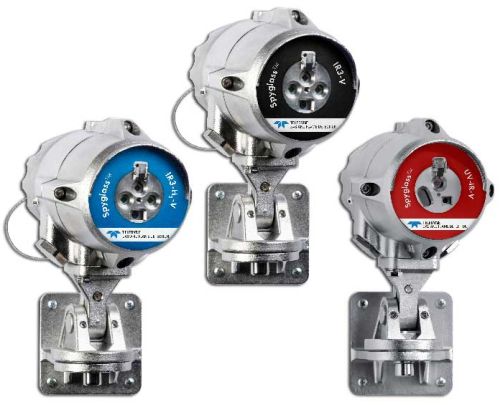The Spyglass family of triple IR and UV-IR flame detectors provide top-tier optical flame detection with faster detection time and performance over long distances. Spyglass flame detectors also feature industry-leading false alarm immunity in various challenging environments, enabling them to perform reliably in adverse climates.
All members of the Spyglass family are available, offering the option to choose built-in high-definition video, which enables users to make critical safety decisions from a distance.
Spyglass SG50-F Series are designed to provide superior performance for a wide variety of fires in a rugged, durable housing. The option of built-in video gives the ability to see and record fires without being on the scene.
Small in size and affordable, with state-of-the-art features, the Spyglass makes it a desirable tool for anyone concerned about fires in their facilities.
Why Spyglass Flame Detectors?
- Global approvals including FMus, FMc, ATEX, IECEx, and UKEX
- SIL2 Certified
- Long detection distances, low false alarms
- Ability to detect difficult fires, including Alternate Energy Fuels, Munitions, Arcs/Sparks in windmills, Hot exhaust of engines, such as helipads and NFPA33 standard
- Available with multiple outputs including: 0 – 20mA, Modbus, HART and Fire, Fault, & Auxiliary relays
Spyglass Flame Detectors with Integrated High-Definition Video
High-Definition (HD) Camera allows for precise imaging of fires at a distance of 100 ft. (30m). Connecting to a video system allows remote verification of fire, allows the first responders to be aware of the exact situation before entering the hazardous area, and can be used for post-fire analysis of the cause of the fire.
A video recording of up to 1 minute pre-event and up to 3 minutes post-event is captured by the detector.
Video units are available with either colour or near-infrared video. Colour is best for hydrocarbon fires and to give a realistic view. Some fires from fuels such as hydrogen and alcohol can be virtually invisible to the human eye, and also do not show up well on colour video.
Near-infrared video is best suited for these hard-to-see fires, as it provides a clearer view of the flames’ extent.
High Definition Video
- Colour or near-infrared
- Real-time Information
- Remote monitoring of unmanned locations
- Review fire causes and responses
- Remove the uncertainty of releasing suppression systems
Triple Infrared Technology
- Long detection distance
- Sensitivity to small fires
- Immunity to false alarms
Spyglass IR3 – Detecting hydrocarbon fires.
Spyglass IR3-H2 – Detection of hydrogen flames, ammonia, and silane.
Ultraviolet and Infrared Technology
- Proven technology
- Metal fire detection
- Indoor installation
Spyglass UV-IR-F – Detecting hydrocarbon fires.
Spyglass UV-IR – Detection of hydrogen flames, metal and inorganic flames.
Xtend
The use of triple infrared technology combined with a specific algorithm enables Spyglass IR3 H₂ Xtend to detect hydrogen flames simultaneously with those from hydrocarbon fires. Hydrogen flame detection performance remains identical to that of the version of Spyglass IR3-H₂ dedicated exclusively to hydrogen.
Typical applications include electrolysers, hydrogen stations, SMRs, and dense industrial areas with potential hydrogen flames.
Hot CO2 Rejection
The CO₂ rejection option, available with IR3 HC technology, offers fast, reliable detection on a wide range of hydrocarbon fires where combustion exhaust gases may be present. As well as detecting actual fires, the detector analyses and rejects any false signal from hot CO2 exhaust.
Typical applications: aircraft hangars, civil or military, heliports, areas with heavy automotive activity (such as tunnels or loading bays).
Ultra Fast
The NFPA 33-specific detector has been optimised for ultra-fast fire detection in high-speed production processes.
The detector is designed to meet the NFPA33 standard, which requires the detector to trigger an alarm in the event of an event in less than 0.5 seconds. The range of performance-tested and approved detectors is available in UVIR, IR3 and IR3-H2 configurations.
Typical applications: spray booths for the automotive industry, high-speed printing and coating, conveyors and fast-moving vehicles.

